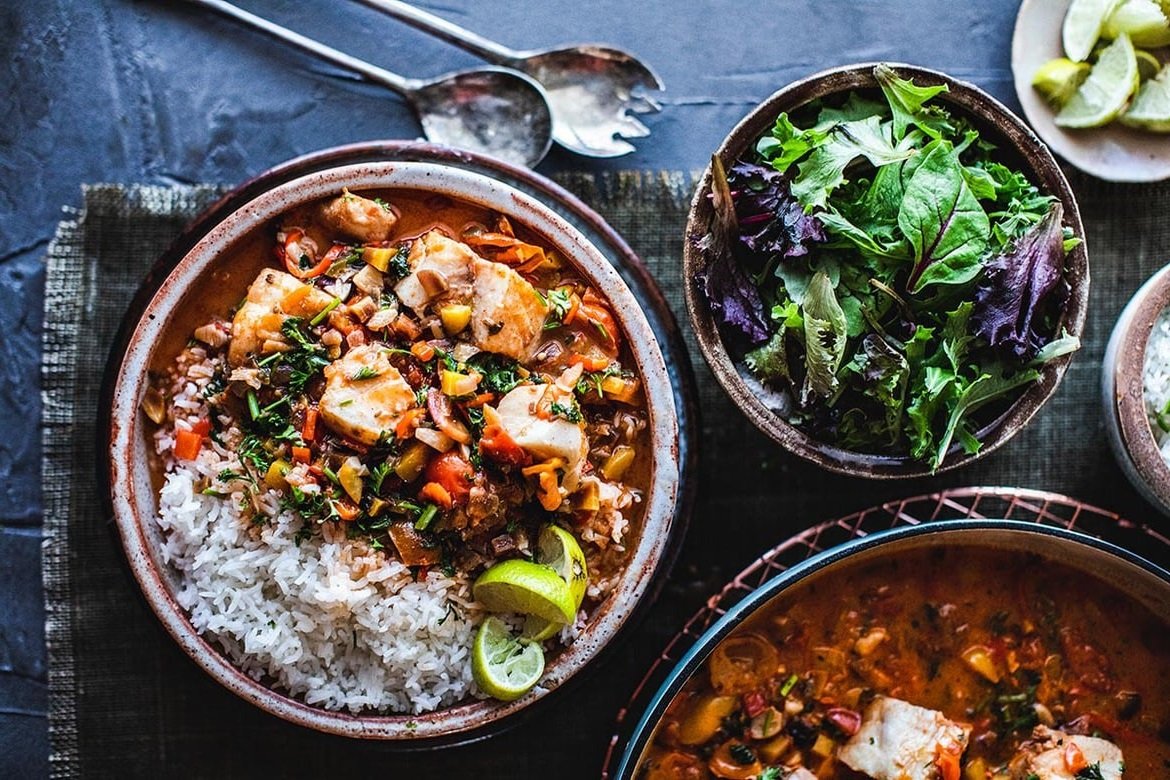The Wandering Kitchen: Brazil
In the Skagit Valley Food Co-op’s Wandering Kitchen Travel Blog Series, we’re taking you on a virtual trip to some of the best places on Earth for world-class cuisine. Whether it comes from your backyard or a different continent, good food has the power to transport you anywhere you want to go. So while you might not travel to the heart of India, the Caribbean, or the boot of Italy by plane, train, or automobile, you can take your taste buds on a trip simply by turning your dining table into a delicious destination for some of the world’s best food.
We’ll be featuring locations near and far known for their food, inspirational recipes to try in your own kitchen, as well as products you can find in the Co-op to give you a taste of the cuisine.
In this edition of The Wandering Kitchen, we’re digging out our long-forgotten swimsuits, sunglasses, and floppy sun hats and taking a trip south of the border to Brazil!
Why Brazil?
With the Carnival of Brazil hosted in the first week of March being the world’s largest carnival, it only makes sense that we take some time to acknowledge all the incredible culinary delights Brazil has to offer. Plus, dreaming of the tropics in the middle of the winter reminds us that summer is always just around the corner.
Brazilian-Inspired Recipes
Photo Courtesy of Feasting at Home
Moqueca
Otherwise known as Brazilian seafood stew, moqueca is traditionally made with shrimp or fish as the base with tomatoes, onions, garlic, lime, and coriander added in for more flavor and heartiness. Slow-cooked in a traditional terracotta cassole, moqueca is a flavorful seafood dish that can be enjoyed any time of the year.
There are two common variations of moqueca: moqueca capixaba and moqueca baiana.
The capixaba variation is native to Espírito Santo, a coastal state in Southeastern Brazil known for its beautiful beaches that stretch as far as the eye can see.
It’s traditionally a lighter version of moqueca, utilizing extra-virgin olive oil in place of palm oil. It’s also made in a special pan, aptly named the capixaba pan, made with black clay and glazed with mangrove tree sap.
The baiana version, on the other hand, was developed in Bahia, a Northeastern state in Brazil that also shares a coastline with the Atlantic. The baiana version is inspired by African and Portuguese cuisines and incorporates palm oil and coconut milk into the traditional moqueca recipe.
In this adaptation from Feasting at Home, Sylvia keeps the recipe pretty traditional, opting for the Baiana version with coconut milk.
Photo Courtesy of Brazilian Kitchen Abroad
Picanha (Brazilian Steak)
If you’ve ever been to a Brazilian steakhouse, you know that it’s an experience - one that involves servers coming to your table, offering you more meat than any one person could really eat in a sitting, with the occasional veggie & fruit buffet to give you something to go along with all your steak.
But before Brazilian steakhouses were popping up all over the United States, Picanha was the beef cut that many considered to be the only proper way to enjoy Brazilian Coulotte steaks. Traditionally, picanha is skewered before being cooked over a charcoal grill. The seasoning here is very mild, consisting of simply salt to allow the rich, beefy flavor to be the star of the show.
While Picanha is a popular cut of beef in Brazil, here in the states it can be challenging to find it at the grocery store. But if you are able to snag a cut, this recipe from Brazilian Kitchen Abroad is a fantastic way to enjoy it.
Though not entirely traditional, here the picanha is cut into 4 steaks before being seasoned with salt, lemon pepper, and a sofrito mixture and grilled to your liking. Serve it along with fresh papaya, mango, and your favorite sides.
Find the full recipe at Brazilian Kitchen Abroad
Pão de Queijo (Cheese Bread)
Let’s be real… who doesn’t like cheese bread? Whether it’s in the form of grilled cheese, garlic bread with ooey-gooey mozzarella, or Brazil’s Pão de Queijo, there’s something so cozy and comforting about that simple bread and cheese combo that seems to stretch across time and cultures.
Originating in the Brazilian state of Minas Gerais, Pão de Queijo is a traditional recipe that has quite a history. Originally, Pão de Queijo was eaten by enslaved people in Brazil. Without wheat flour being readily available, the Brazilians would soak and peel cassava root to make the bread from. At that time, cheese wasn’t incorporated.
As time went on and more ingredients become readily available, and both cheese and eggs were introduced to the recipe, creating what we now recognize as Pão de Queijo. Nowadays, the cheesy treat is enjoyed at breakfast or as a snack in Brazil, Portugal, East Asia, Australia, and the U.S. And since they’re gluten-free by nature, Pão de Queijo is a wonderful treat for everyone!
In this simple recipe, all you’ll need is an egg, olive oil, milk, tapioca flour (you can find it at the Co-op!), grated cheese, and a pinch of salt. All the ingredients are simply blended up, popped into some muffin tins, and baked until puffy and browned. Enjoy them alongside other Brazilian recipes or just as a weekend snack!
Photo Courtesy of Curious Cuisinière
Feijoada (Black Bean Stew)
Though Feijoada is said to originate in Portugal, it has become a mainstay in Brazilian cuisine and is sometimes called the national dish of Brazil.
Popularized in the regions of Rio de Janeiro, São Paulo, and Salvador, feijoala is a simple, but flavorful stew made up of pork, beef, and black beans. Traditionally, feijoada is made with pig’s ear, feet, and snout, along with Brazilian sausage.
Nowadays, you’ll find feijoada made with a variety of pork or beef products, including pork trimmings, bacon, smoked ribs, and two types of smoked sausage or jerked beef. When all that meat is paired with black beans and slow-cooked, you end up with a deeply flavored stew that can feed a whole family, with a little extra for later.
In this recipe from Curious Cuisinière, black beans, bacon, pork ribs, chorizo sausage, and smoked sausage come together to create a less than traditional, though made from accessible ingredients, version of this Brazilian classic.
Photo Courtesy of Olivia’s Cuisine
Empadão
Shepherd’s pie, hand pies, chicken pot pie, minced meat, empanadas… every culture has its own version of a meat filling wrapped up in a floury pastry crust. In Brazil, they have empadão!
Another Portuguese-invented dish that’s taken on its own life in Brazil, empadão is best compared to the English Sheperd’s Pie. Made up of either meat, chicken, or seafood and layered with potatoes, empadão is prepared in a casserole dish and baked to perfection in the oven.
In this recipe, onions and garlic are sauteed and combined with tomatoes, shredded chicken, olives, corn, peas, heart of palm, and tomato sauce to create the filling for this pie. The filling is then added to a homemade dough before being baked till golden brown.
Find the full recipe at Olivia’s Cuisine
Brigadeiro
After all those savory dishes, you’re probably craving a little something sweet to balance you out. Enter: easy-to-make, but super delicious brigadeiro! Though the origins of this confection are a bit hazy, the most prevalent theory is that they were created by a confectioner named Heloisa Nabuco de Oliveira, from Rio de Janeiro.
The name ‘brigadeiro’ is said to come from the presidential campaign of Brigadier Eduardo Gomes, who ran for the Presidency of the Brazilian Republic in 1946. And while he didn’t win the election, his name is forever associated with this delciious treat. And really, what’s a better legacy than having a dessert named after you?
Made up of simply cocoa powder, butter, and sweetened condensed milk, this Brazilian sweet treat is easily the simplest recipe to make at home.
Find the full recipe at AllRecipes
Brazilian Food Staples Available at the Co-op
Tropical fruits available in our Produce Department
Cassava flour, chips, and treats
Coconut milk, black beans, and other pantry staples
Now, if you really want to get yourself craving Brazilian food, we highly recommend that you pop onto Netflix and check out their series Street Food: Latin America! While all the episodes give you a great glimpse into street food throughout Latin America, the 2nd episode of the series focuses on Salvador, Brazil, and features some of the recipes we’ve listed above, including feijoada and moqueca.




